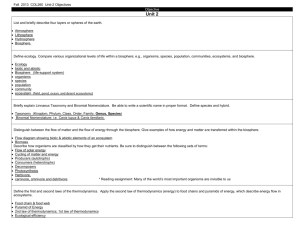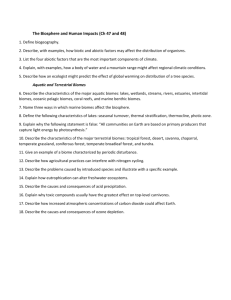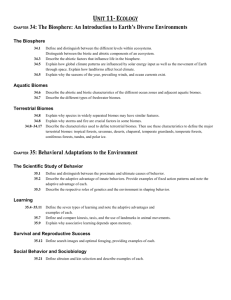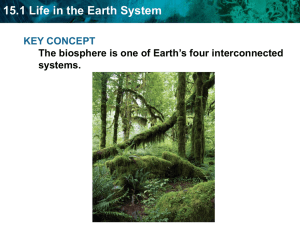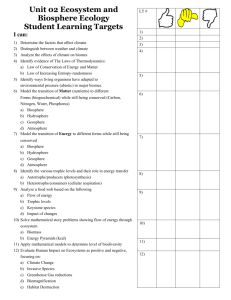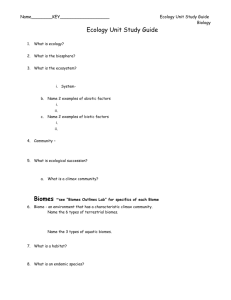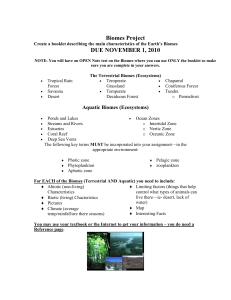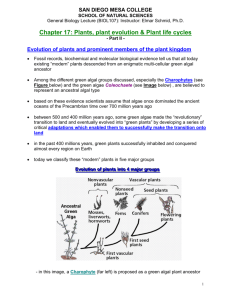The Earth` Ecosystems
advertisement
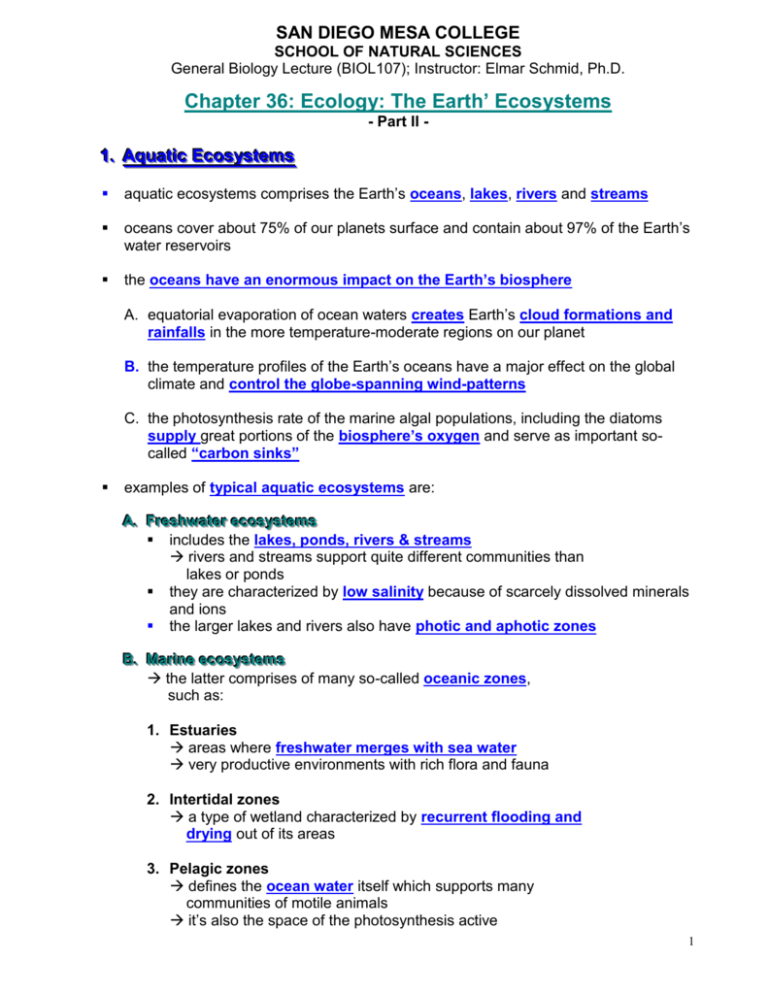
SAN DIEGO MESA COLLEGE SCHOOL OF NATURAL SCIENCES General Biology Lecture (BIOL107); Instructor: Elmar Schmid, Ph.D. Chapter 36: Ecology: The Earth’ Ecosystems - Part II - 11.. A Aqquuaattiicc E Eccoossyysstteem mss aquatic ecosystems comprises the Earth’s oceans, lakes, rivers and streams oceans cover about 75% of our planets surface and contain about 97% of the Earth’s water reservoirs the oceans have an enormous impact on the Earth’s biosphere A. equatorial evaporation of ocean waters creates Earth’s cloud formations and rainfalls in the more temperature-moderate regions on our planet B. the temperature profiles of the Earth’s oceans have a major effect on the global climate and control the globe-spanning wind-patterns C. the photosynthesis rate of the marine algal populations, including the diatoms supply great portions of the biosphere’s oxygen and serve as important socalled “carbon sinks” examples of typical aquatic ecosystems are: A A.. FFrreesshhw waatteerr eeccoossyysstteem mss includes the lakes, ponds, rivers & streams rivers and streams support quite different communities than lakes or ponds they are characterized by low salinity because of scarcely dissolved minerals and ions the larger lakes and rivers also have photic and aphotic zones B B.. M Maarriinnee eeccoossyysstteem mss the latter comprises of many so-called oceanic zones, such as: 1. Estuaries areas where freshwater merges with sea water very productive environments with rich flora and fauna 2. Intertidal zones a type of wetland characterized by recurrent flooding and drying out of its areas 3. Pelagic zones defines the ocean water itself which supports many communities of motile animals it’s also the space of the photosynthesis active 1 SAN DIEGO MESA COLLEGE SCHOOL OF NATURAL SCIENCES General Biology Lecture (BIOL107); Instructor: Elmar Schmid, Ph.D. phytoplankton, including the marine algae, cyanobacteria and the zooplankton, e.g. the Krill 4. Benthic zones defines the ocean floors including its unique flora and fauna depending on the depth and light penetration, the benthic community consists of attached algae, fungi, bacteria, sponges, burrowing worms, sea anemones, clams, crabs and fish 5. Photic zone comprises the benthic and pelagic oceanic zones, which receive ample light to enable photosynthetic processes and the development of complex food chains 6. Aphotic zone the vast, dark regions (= “abyssal regions”) of the oceans, which are not reached by the solar light anymore it is the most extensive but least explored part of the Earth’s biosphere in the recent years scientists discovered surprisingly diverse and “alien” life forms in this region, especially so-called hydrothermal vent communities thriving around submersed volcanoes (= black smokers”) 2. Terrestrial Ecosystems (= Biomes) the Earth houses nine major types of terrestrial ecosystems, or also called biomes, which cover the land surface the distribution of the biomes largely depends on climate factors, and strictly follow the global temperature lines and rainfall indices each biome is characterized by a type of perfectly adapted biological community, comprising a different assembly of species in different biomes widely separated biomes may look alike and house independently evolved species with similar traits; this phenomenon is called convergence today many biomes are broken up and disturbed by human land development, industrial and agricultural activities 2 SAN DIEGO MESA COLLEGE SCHOOL OF NATURAL SCIENCES General Biology Lecture (BIOL107); Instructor: Elmar Schmid, Ph.D. A closer look at the nine major biomes on planet Earth (listed beginning with the most northern biomes) 1. Polar ice caps and high mountain ice 2. Tundra (arctic and alpine) stretches at the northernmost limit of plant growth below areas of permanent ice and snow = arctic regions 3. Coniferous forests areas include Northeastern US, Russian taiga, Scandinavia, and vast parts of New Zealand 4. Temperate deciduous forest grow in latitudes between 35o – 50o areas include Eastern North America, Central Europe, Eastern Asia and Australia 5. Temperate grass land found in regions which climate is characterized by relatively cold winter temperatures and seasonal droughts; important regions on Earth are: e.g. Pampas Argentina Prairie North America Steppes Asia, Mongolia intensively farmed and belong to the most productive agricultural regions on our planet 6. Chaparral characterized by dense, spiny scrubs with touch, evergreen leaves, e.g. Jojoba bush, Brittle bush, etc. Important chaparral regions on Earth are: e.g. Mediterranean region (S. Italy, S. Spain) Coastal areas of Chile SW Africa SW Australia Southern California 7. Desert biomes which climate is characterized by low rainfalls (< 30cm/year) and usually high daytime temperatures; evaporation greatly exceeds precipitation important desert regions on Earth are: e.g. Kalahari desert Africa Gobi desert Central Asia Sahara desert N. Africa Arabian desert E. Africa Sonora, Anza Borrego desert NW America 3 SAN DIEGO MESA COLLEGE SCHOOL OF NATURAL SCIENCES General Biology Lecture (BIOL107); Instructor: Elmar Schmid, Ph.D. today, deserts are growing in size due to conversion of other biomes and anthropogenic deforestation 8. Savanna biome dominated by grass and scattered trees 9. Tropical rainforest are the most complex of all biomes characterized by an enormously rich diversity of biological organisms (= biodiversity) e.g. up to 300 different species can be found in a single hectar experiences the highest rate of species extinction 3. The Biosphere the biosphere is the total of all ecosystems existing on planet Earth … it is the global ecosystem! it is the thin portion of Earth that harbors all life forms and supports the life functions The biosphere is comprised of only a very thin, life-supporting layer which surrounds the Earth; this layer consists of the following parts and regions 1. Atmosphere The air-filled layer which reaches from sea level to an altitude of about 6-7 km 2. Land The crystallized, solid magma layer (which reaches down to approx. 1500 m depth), including the water-bearing rocks, its erosion forms and the very thin top layer called soil the lakes, rivers and streams the caves 3. Oceans The salt water-containing layer which reaches down to a maximum depth of about 11 km (Marianna fault) 4. Cryosphere The regions of permanent ice and snow, including the polar caps, central Green land, high mountain glaciers The biosphere is a closed, self-contained and life-sustaining system, which has only two major interactions with the surrounding space 1. its primary food producers, i.e. the photosynthesizing organisms, ultimately depend on the incoming electromagnetic energy, most of all the visible light, from the sun 2. it transmits heat energy back into space during the night periods 4 SAN DIEGO MESA COLLEGE SCHOOL OF NATURAL SCIENCES General Biology Lecture (BIOL107); Instructor: Elmar Schmid, Ph.D. one of the hallmark features of the Biosphere is its patchiness or fractalization into different habitats, e.g. forests, lakes, rivers, meadows, etc. the life in the biosphere is dependent on and influenced by many physical and chemical, so-called abiotic factors the most important abiotic factors are: 1. Solar energy powers nearly all surface terrestrial and shallow water ecosystems is the limiting factor for many aquatic ecosystems 2. Water limiting factor for all terrestrial life forms and crucial parameter in terrestrial ecosystems 3. Temperature most biological organisms can only maintain a productive metabolism at temperatures higher than 0oC and lower than 40oC temperatures higher than 50oC destroy the enzymes, which catalyze the biochemical reactions within the organisms bodies 4. Wind nutrients of many organisms are spread and delivered by wind the successful reproduction of many plants is strictly dependent on wind pollination local wind damage by strong winds, e.g. taifuns or hurricanes, create openings in forests that enable succession and increase in patchiness 5. Soil Structure/Composition various stages of decomposition of organic matter, pH, nutrient content, mineralization, all contribute to soil structure and composition 6. Wildfires, e.g. caused by lightning the germination of certain plant species is triggered by the heat of wild fires the survival of certain plant species, e.g. sequoias, is dependent on recurrent wildfires which eliminate competing plants 5 SAN DIEGO MESA COLLEGE SCHOOL OF NATURAL SCIENCES General Biology Lecture (BIOL107); Instructor: Elmar Schmid, Ph.D. on the other hand, the inter-dependently and highly dynamically interacting life forms in the biosphere can influence many important factors of the biosphere, such as gas composition, water quality, erosion and sedimentation rates, etc. due to the enormous and steadily increasing impact of a rapidly growing human population on the biosphere, a thorough study and understanding of the biosphere’s structure, dynamics and inter-dependencies is of crucial importance to ultimately avoid future environmental dilemmas caused by human activities today the diversity of our biosphere is touched and threatened by the many human activities and modern technology, e.g. urbanization, creation of vast agricultural mono-cultures, deforestation, mining, oil drilling evaluating the impact of human activity and technology on our Biosphere mandates a detailed knowledge and scientific study of its structures and dynamics 6
